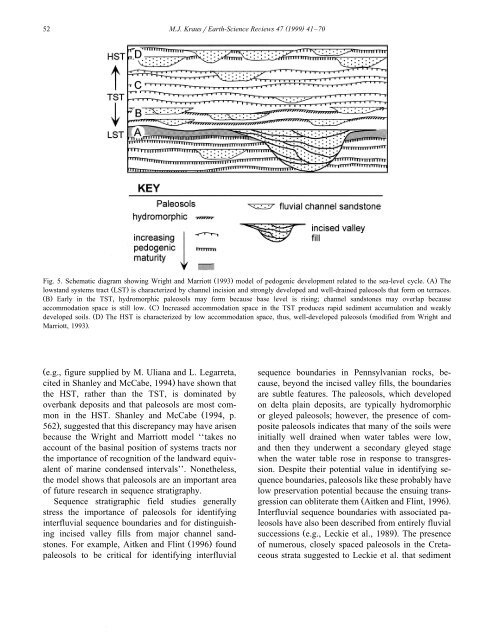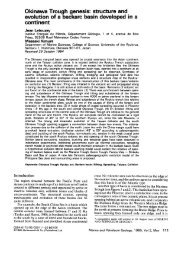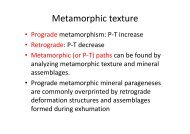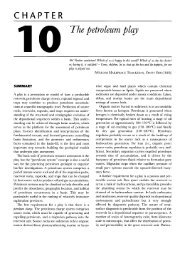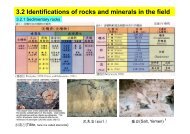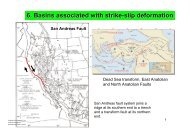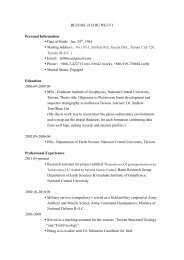Paleosols in clastic sedimentary rocks: their geologic applications
Paleosols in clastic sedimentary rocks: their geologic applications
Paleosols in clastic sedimentary rocks: their geologic applications
- No tags were found...
Create successful ePaper yourself
Turn your PDF publications into a flip-book with our unique Google optimized e-Paper software.
52( )M.J. KrausrEarth-Science ReÕiews 47 1999 41–70Fig. 5. Schematic diagram show<strong>in</strong>g Wright and Marriott Ž 1993. model of pedogenic development related to the sea-level cycle. Ž A.Thelowstand systems tract Ž LST.is characterized by channel <strong>in</strong>cision and strongly developed and well-dra<strong>in</strong>ed paleosols that form on terraces.Ž B.Early <strong>in</strong> the TST, hydromorphic paleosols may form because base level is ris<strong>in</strong>g; channel sandstones may overlap becauseaccommodation space is still low. Ž C.Increased accommodation space <strong>in</strong> the TST produces rapid sediment accumulation and weaklydeveloped soils. Ž D.The HST is characterized by low accommodation space, thus, well-developed paleosols Žmodified from Wright andMarriott, 1993 ..Že.g., figure supplied by M. Uliana and L. Legarreta,cited <strong>in</strong> Shanley and McCabe, 1994.have shown thatthe HST, rather than the TST, is dom<strong>in</strong>ated byoverbank deposits and that paleosols are most common<strong>in</strong> the HST. Shanley and McCabe Ž1994, p.562 ., suggested that this discrepancy may have arisenbecause the Wright and Marriott model ‘‘takes noaccount of the bas<strong>in</strong>al position of systems tracts northe importance of recognition of the landward equivalentof mar<strong>in</strong>e condensed <strong>in</strong>tervals’’. Nonetheless,the model shows that paleosols are an important areaof future research <strong>in</strong> sequence stratigraphy.Sequence stratigraphic field studies generallystress the importance of paleosols for identify<strong>in</strong>g<strong>in</strong>terfluvial sequence boundaries and for dist<strong>in</strong>guish<strong>in</strong>g<strong>in</strong>cised valley fills from major channel sandstones.For example, Aitken and Fl<strong>in</strong>t Ž 1996.foundpaleosols to be critical for identify<strong>in</strong>g <strong>in</strong>terfluvialsequence boundaries <strong>in</strong> Pennsylvanian <strong>rocks</strong>, because,beyond the <strong>in</strong>cised valley fills, the boundariesare subtle features. The paleosols, which developedon delta pla<strong>in</strong> deposits, are typically hydromorphicor gleyed paleosols; however, the presence of compositepaleosols <strong>in</strong>dicates that many of the soils were<strong>in</strong>itially well dra<strong>in</strong>ed when water tables were low,and then they underwent a secondary gleyed stagewhen the water table rose <strong>in</strong> response to transgression.Despite <strong>their</strong> potential value <strong>in</strong> identify<strong>in</strong>g sequenceboundaries, paleosols like these probably havelow preservation potential because the ensu<strong>in</strong>g transgressioncan obliterate them Ž Aitken and Fl<strong>in</strong>t, 1996 ..Interfluvial sequence boundaries with associated paleosolshave also been described from entirely fluvialsuccessions Ž e.g., Leckie et al., 1989 .. The presenceof numerous, closely spaced paleosols <strong>in</strong> the Cretaceousstrata suggested to Leckie et al. that sediment


